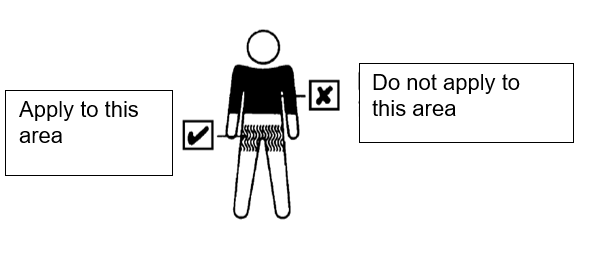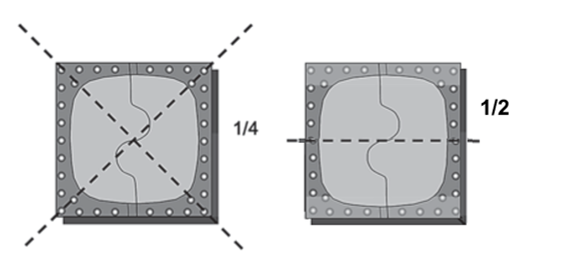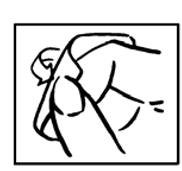Introduction
During puberty, oestrogen is released from the ovaries for the development of breasts, pubic hair and menstrual cycles along with strengthening bones. Some girls are unable to make oestrogen themselves. This can be due to a range of reasons including faulty signals from the brain to the ovaries, ovaries which do not respond to the brain’s signals or absence of the ovaries.
If oestrogen needs to be given artificially, this is called induction of puberty and will take place over approximately two years. The dose will start low and will gradually be increased when you attend the clinic around every three to six months.
Oestrogen patches
The oestrogen in the patches is absorbed into the body through the skin and replaces the oestrogen which the body cannot make itself. The patches are called Evorel 25 ®.
Using the patches
The patches will need to be changed twice a week. This will need to be done on the same two days every week and means that one patch is on for three days and the other for four days. Examples of the days of the week for your patch change days are below, for example Mondays and Thursdays. Once you finish one pack, start another one. There is no need to leave a break between packs.
- Monday and Thursday
- Tuesday and Friday
- Wednesday and Saturday
- Thursday and Sunday
- Friday and Monday
- Saturdy and Tuesday
- Sunday and Wednesday
Where to put the patches
The patches need to be stuck onto a hairless area of skin below the waist. Most girls prefer to wear the patch on the thigh, bottom or you could try applying the ¼ size patches point down at the base of the spine.

- Apply the patch to clean, dry, cool skin as soon as you open the protective pouch.
- Do not apply on or near the breasts.
- Do not put it on top of cuts, spots or anywhere the skin is irritated.
- Do not use cream, moisturiser or talc before applying the patch.
- Do not apply the patch on the same area of skin twice in a row.
- Do not wear a patch under elasticated areas or a tight waistband.
How to apply the patches
Step 1 Opening the patches

- Using the notches as a guide, tear along two edges of the pouch and remove the patch.
- With the protective backing facing you, bend and peel off half the backing. Do not touch the sticky side or it may not stick properly.
Step 2 Cutting the patches

The oestrogen patches are not made in lower doses so you will need to cut them to the dose your doctor has prescribed for you.
Step 3 apply and press

- Apply the open half of the patch to your skin.
- Remove the remaining backing and press down the rest of the patch.
- Press the patch with the palm of your hand to make sure it is firmly stuck.
When using smaller part patches, try using tape e.g. micropore to ensure good adhesion.
How to remove the patches

- Peel an edge of the patch smoothly away from the skin.
- Fold the patch in half, so that the sticky side sticks to itself.
- Put it in with the household rubbish, safely out of the reach of children and pets.
- Do not flush used patches down the toilet.
- When you remove the patch some glue may remain on your skin. It will disappear with time, or you can use baby oil to remove it.
Questions and answers
What if a patch falls off?
Apply a new patch but keep to your original patch change days. If you have just had a bath or shower, wait until your skin cools before applying a new patch.
What if I forget to change the patch?
Change it as soon as you remember and then keep to your original patch change days.
Can I have a bath or shower?
Yes, you can bath or shower as normal but avoid scrubbing to hard as the edges of the patch might come away from the skin.
Can I play sport?
Yes, you can play sport, go swimming and exercise but is better to avoid wearing the patch under tight clothing or waistbands.
Can I sunbathe?
Yes but you need to keep the patch covered and out of direct sunlight.
Where should I store my patches?
Your patches should be stored below 25°c in their original packaging. Any partly used patches can be stored in the fridge for up to a week.
Are there any side effects?
Sometimes people get irritated, red, puffy and itchy skin where the patch has been applied. Some people also get breast pain, a rash, feeling itchy, dizzy or headaches.
Who should I contact if I need any help?
If you need any help, support or advice please contact the paediatric endocrine nurses on (01223) 217496.
References/sources of evidence
Evorel 25 ® Patient Information Leaflet April 2016
Matthews D et al (2007) Hormone supplementation for pubertal induction in girls Archives of Disease in Childhood 102:975-980
We are smoke-free
Smoking is not allowed anywhere on the hospital campus. For advice and support in quitting, contact your GP or the free NHS stop smoking helpline on 0800 169 0 169.
Other formats
Help accessing this information in other formats is available. To find out more about the services we provide, please visit our patient information help page (see link below) or telephone 01223 256998. www.cuh.nhs.uk/contact-us/accessible-information/
Contact us
Cambridge University Hospitals
NHS Foundation Trust
Hills Road, Cambridge
CB2 0QQ
Telephone +44 (0)1223 245151
https://www.cuh.nhs.uk/contact-us/contact-enquiries/

